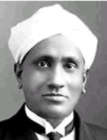 Indian physicist, the recipient of the Nobel Prize for Physics in 1930
Indian physicist, the recipient of the Nobel Prize for Physics in 1930
(birth. Nov. 7, 1888, Trichinopoly [Tiruchirappalli], India; death. Nov. 21, 1970, Bengaluru).
Dr. Chandrasekhara Venkata Raman was an Indian physicist, the recipient of the Nobel Prize for Physics in 1930. He had discovered that when light traverses a transparent material, some of the light that is deflected changes in wavelength, which is now called Raman scattering.
After receiving his master’s degree in physics from Presidency College, University of Madras, in the year 1907, Raman worked as an accountant in the finance department of the Indian government. However he became professor of physics at the University of Calcutta in 1917.
In 1933 he moved to the Indian Institute of Science, Bengaluru, as head of the department of physics. In 1947 he was named director of the Raman Research Institute.
His contribution to the building up of several Indian research institution in his time wee commendable. Raman was awarded with the Bharat Ratna, India’s highest civilian award in 1954.

